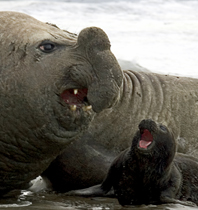|
 |
 | Southern Elephant Seal (Mirounga leonina).  |
 |
Regional Aggregations of the Southern Elephant Seal (Mirounga leonina).
References. Green dots: colonies or breeding aggregations, and the percentage of the world population that each area represents. Blue text: those populations for which the Atlas provides distribution data. Red text: populations for which there are no data. Blue circle: colonies of origin of individuals studied with remote tracking devices.
| © Jim Large |
 |
Breeding aggregations |
 Trajectories Trajectories |
The overlapping trajectories (satellite tracking) of Southern Elephant Seals from Valdes Peninsula (red) and South Georgia (blue) are presented. There is a degree of overlap in the feeding areas. The distribution at sea of individuals from Valdes Peninsula stretches beyond the limits of the Patagonian Sea into the Pacific Ocean. Only a few individuals from the South Georgia reach the Patagonian Sea during the pelagic stages of the annual cycle.
Data on individuals of both sexes from Valdes Peninsula (21 adults and 41 juveniles) and from South Georgia (26 adults). All available data between January and December are shown without distinguishing between seasons.
Dataholders: M. Fedak (South Georgia); C. Campagna, M. Lewis and M.R. Marín (Valdes Peninsula).
 |  Areas of Special Relevance Areas of Special Relevance |
The Southern Elephant Seal of Valdes Peninsula is distributed in the zones of the slope and principal oceanic fronts of the continental shelf. Individuals from South Georgia use sub-Antarctic waters, although they may reach the edge of the Patagonian continental shelf and the slope. The waters that surround the Malvinas Islands are visited by individuals of both populations.
Data on individuals of both sexes from Valdes Peninsula (21 adults and 41 juveniles) and from South Georgia (6 adults). All available data between January and December are shown without distinguishing between seasons.
Dataholders: M. Fedak (South Georgia); C. Campagna, M. Lewis and M.R. Marín (Valdes Peninsula).
 Feeding areas (Adults) Feeding areas (Adults) |
The males of Southern Elephant Seal use the continental shelf and the slope, whereas the females reveal the greatest dispersion, mostly using waters of the slope and the ocean basin. Consequently, the distance travelled by females is significantly greater than that by males.
Data on 8 males and 13 females from Valdes Peninsula. All available data between January and December are shown without distinguishing between seasons.
Dataholders: C. Campagna, M. Lewis and M.R. Marín.
 |  Feeding areas (Juveniles) Feeding areas (Juveniles) |
Juveniles of Southern Elephant Seal (1 to 3 years old) travel similar distances than adults. Males and females have also similar distribution patterns than the adults of the same sex. Males range widely along the edge of the shelf while females travel to the ocean basin. One female traveled to the Pacific Ocean passing through the Drake Passage and the Magellan Straits.
Data on 17 males and 6 females from Valdes Peninsula. All available data between January and December are shown without distinguishing between seasons.
Dataholders: C. Campagna, M. Lewis and M.R. Marín.
 Spring (Valdes Peninsula) Spring (Valdes Peninsula) |
In Spring, adults and juveniles of Southern Elephant Seal use the edge of the slope, the Magellan front and the waters that surround the Malvinas Islands.
Data on 16 adults and 33 juveniles from Valdes Peninsula. Period: October-December.
Dataholders: C. Campagna, M. Lewis and M.R. Marín.
 |  Summer (Valdes Peninsula) Summer (Valdes Peninsula) |
In Summer, juveniles and adults of Southern Elephant Seal from Valdes Peninsula make intense use of the slope from the Río de la Plata to the south of the San Jorge Gulf.
Data on 12 adults and 24 juveniles from Valdes Peninsula. Period: January-March.
Dataholders: C. Campagna, M. Lewis and M.R. Marín.
 Autumn (Valdes Peninsula) Autumn (Valdes Peninsula) |
In Autumn, Southern Elephant Seals from Valdes Peninsula (both sexes and various age categories) are distributed to the south of the slope and around the Malvinas Islands.
Data on 5 adults and 17 juveniles from Valdes Peninsula. Period: April-June.
Dataholders: C. Campagna, M. Lewis and M.R. Marín.
 |  Winter (Valdes Peninsula) Winter (Valdes Peninsula) |
In Winter, Southern Elephant Seals (males and females, juveniles and adults) make greater use of the waters of the shelf, particularly on the slope off the south of the San Jorge Gulf and south-east of Malvinas.
Data on 6 adults and 24 juveniles from Valdes Peninsula. Period: July-September.
Dataholders: C. Campagna, M. Lewis and M.R. Marín.
|
 |
Southern Elephant Seal
Mirounga leonina
Location of the Regional Aggregations: With exception of Valdes Peninsula (the only continental breeding colony), Malvinas Islands and Gough Island (Tristan da Cunha) in the South Atlantic, Southern elephant seals are found on subantarctic islands: South Georgia (more than half of the entire species), South Shetland, South Orkney and Bouvet Islands (South Atlantic); Crozet, Prince Edward and Kerguelen (Southern Indian Ocean), and Macquarie Islands (Southwest Pacific). Diet: Squid and pelagic fish. They can dive uninterruptedly, staying under water between 20 and 30 minutes and reaching maximum depths of up to 1,500 m. World breeding population: Estimated at 600,000-700,000. South Georgia (most important aggregation), approximately 350,000 individuals. Valdes Peninsula, estimated at 50,000 individuals. Conservation Status: Least concern (IUCN, 2008). Main threats: There have been significant population decreases in several aggregations due to unknown causes. There is some concern over the potential impact of climate change on the availability and distribution of prey.

|

